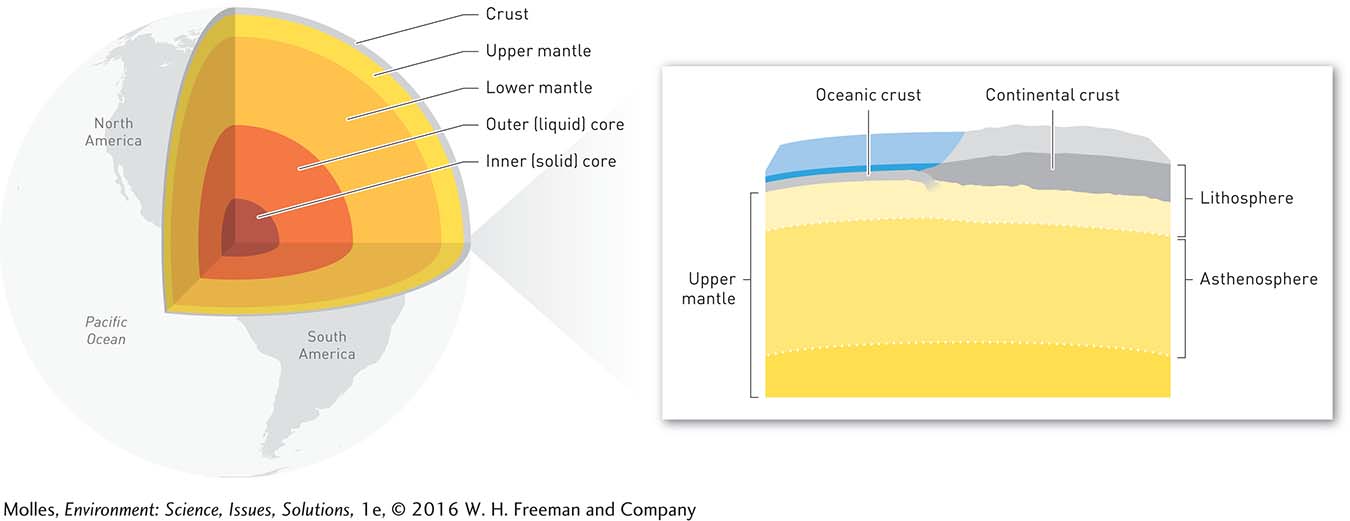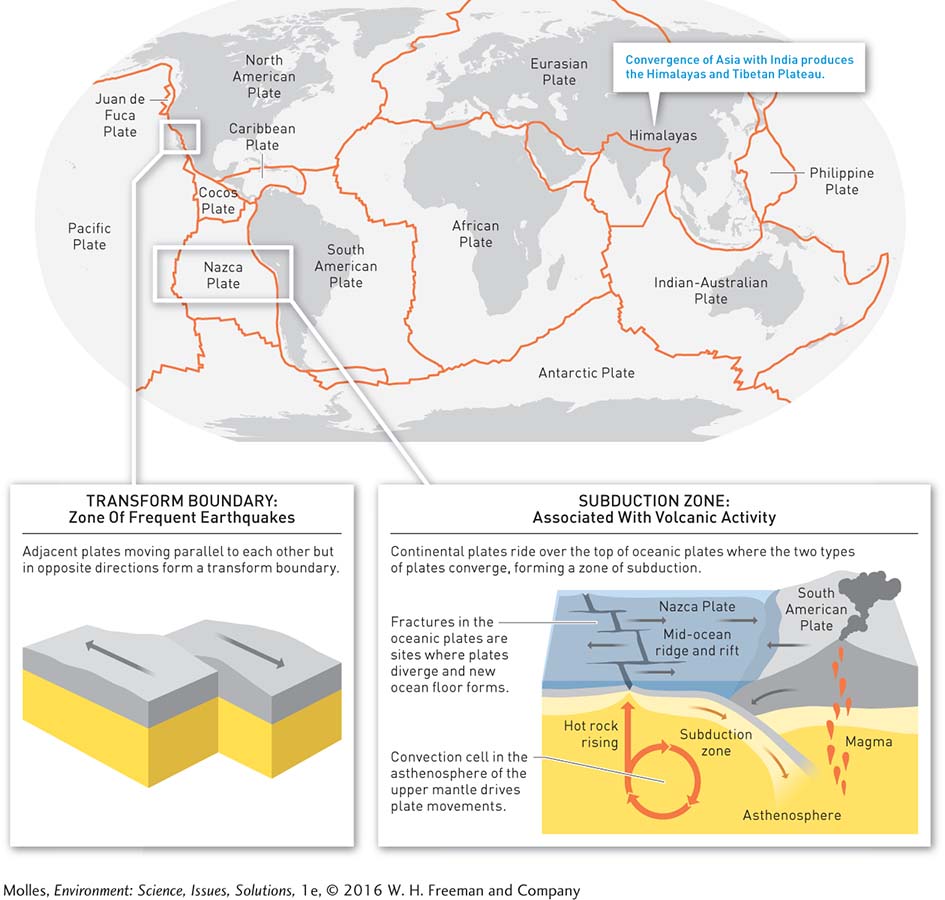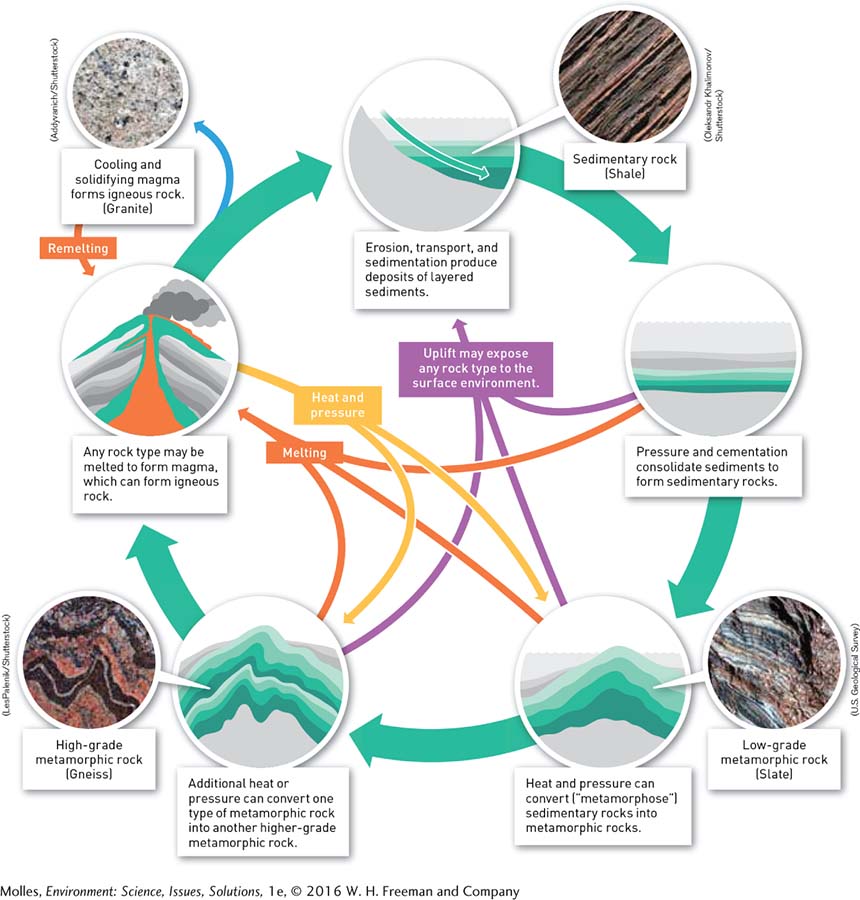Appendix B: The Rock Cycle: Product of a Dynamic Planet
Appendix B
The Rock Cycle: Product of a Dynamic Planet
B-
All ecosystems, from oceans to deserts, develop and function on a geologic foundation of rock. However, as we shall see, this geologic foundation is not static but is renewed over very long timescales in a process called the rock cycle. We begin our exploration of the rock cycle with a review of Earth structure.
Earth Structure
crust The relatively low-
mantle The layer of Earth between the crust and the core; represents the largest portion of Earth’s volume and consists of higher-
Earth can be divided into three major layers: core, mantle, and crust (Figure B.1). The crust, which is made up of relatively low-

lithosphere The uppermost layer of the upper mantle above the asthenosphere, consisting of rigid, relatively brittle rocks.
asthenosphere The layer of the upper mantle immediately below the lithosphere; has an overall consistency similar to plastic.
core The core of Earth consists of an outer liquid layer of molten iron and nickel and a solid, inner iron–
The uppermost layer of the upper mantle consists of rigid, relatively brittle rocks, which, along with Earth’s crust, make up the lithosphere. In contrast, most of the upper mantle has a consistency similar to plastic, and a small portion of it is liquid. This softer portion of the upper mantle is called the asthenosphere. The lower mantle is composed of solid rock of higher density than the upper mantle. The core of the planet, which extends from about 2,900 kilometers to 6,370 kilometers (1,800 to 3,955 miles) in depth at the center of the planet, is also two-
Earth is stratified not only by density but also by temperature and pressure. Temperature and pressure are lowest at Earth’s surface and increase gradually with depth below the surface, until the highest temperatures and pressures are reached at the core. Geologists estimate that the temperature at the solid inner core may be nearly 8,000°C, whereas the temperature of the liquid outer core may be slightly less than 5,000°C. If temperatures increase with depth below the surface of Earth, how can the upper mantle and upper core be liquid while the lower mantle and inner core are solid? Earth scientists explain this apparent contradiction by pointing out that the higher pressures at greater depth keep materials solid at higher temperatures. The physical structure of Earth forms the basis for important Earth processes. One of the most consequential of those processes is plate tectonics.
B-
Plate Tectonics
plate tectonics A theory proposing that Earth’s surface is divided into plates that move on the upper layer of the mantle; explains Earth structure and processes, including the formation of ocean basins, continents, and the geographic distribution of earthquakes and volcanic activity.
The theory of plate tectonics explains the mechanisms responsible for some of Earth’s most dramatic features and processes, including the formation of ocean basins, continents, and mountains, as well as the geographic distributions of earthquakes and volcanic activity. Because it can account for so many geologic phenomena, the theory of plate tectonics unifies geology in a way similar to how the theory of evolution unifies biology.
There is abundant evidence that the surface of Earth is not one continuous layer of crust overlying the mantle. Rather, Earth’s surface is divided into several plates of lower-

B-
convection cell Pattern of circulation caused by differing temperatures in a liquid or gas due to, for example, varying temperatures in Earth’s semi-
Geologists propose that convective currents in the asthenosphere drive the movements of the plates. These convection currents form as hotter material deeper within the mantle rises toward the surface of Earth. This material rises because it has a lower density than the cooler material above it. However, as the lower-
B-
The convection cells within the asthenosphere pull the plates along, putting them in motion. These moving plates are thus literally on a collision course with each other. The fastest ones move only a few centimeters per year, but tremendous forces are involved—
subduction Process in which one tectonic plate moves under another, generally occurring where oceanic plates, which are of higher density, collide with continental plates.
subduction zone Zone where oceanic plates and continental plates collide, forming deep sea trenches and active volcanoes along the continental margin.
Because oceanic plates are of higher density than continental plates when the two plate types collide, the oceanic plate generally moves under the continental plate in a process known as subduction. Collisions between oceanic plates and continental plates form deep trenches in the subduction zone and active volcanoes along the continental margin.
During Earth’s estimated 4.5-
The Rock Cycle
rock A natural, solid, inorganic substance formed from one or more minerals.
igneous rock Rock formed as molten rock cools and solidifies.
sedimentary rock Rock formed either as rock fragments deposited by water, wind, or ice are cemented together and solidify or as rock forms through chemical precipitation.
metamorphic rock Rock formed when any type of rock changes as it is subjected to heat and pressure.
rock cycle Geologic processes that convert each of the three major rock types (igneous, sedimentary, and metamorphic) into one of the other types.
At the center of most Earth processes are rocks, naturally occurring solid materials formed as a mixture of one or more minerals. Igneous rock forms as molten rock cools and solidifies. Sedimentary rock forms either as rock fragments deposited by water, wind, or ice are cemented together and solidify or by chemical precipitation, a process by which a dissolved substance goes from dissolved to solid state in a body of water, such as a pond or sea, and settles to the bottom. Metamorphic rock forms when any type of rock is transformed by exposure to high heat and pressure. During Earth’s history, rocks have been made and remade many times by the rock cycle (Figure B.3).
